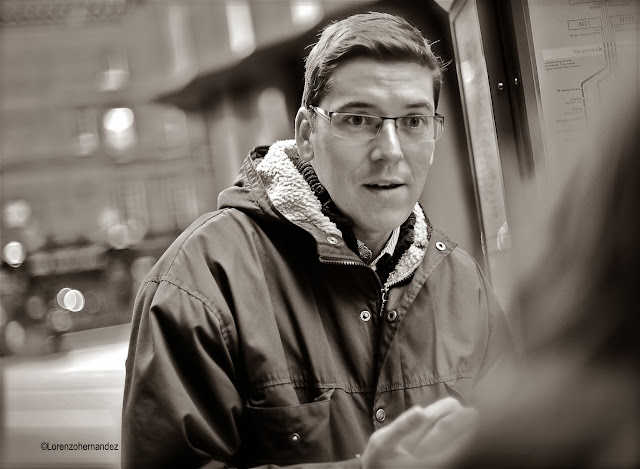One of the
most amazing persons I have ever met was a Japanese gentleman called Nozomu
Sekine. We were both studying French at the EOI Malaga when we met. Every year
he spent eleven months in Spain, where he studied and travelled. During the
other month, usually in spring, he travelled to Japan to visit his family. We
used to sit together in class, revise our homework and soon we became friends.
I introduced him to Carla and Lorenzo, who made his portrait. When his wife
visited him in Malaga, they came over for dinner. It was one of the most
enriching multicultural experiences I have ever had, guided by our friends Luis
and Noriko.
One day, I
asked Nozomu, who was approaching the age of eighty: Don’t you miss your family in Japan, your wife, your children and
grandchildren? He said: Yes, but I
have so much to learn
Darren
Gormley is not thirty yet, but he has the same kind of spirit and I can
perfectly imagine him saying the same in fifty years’ time. He works visiting
people with dementia at their homes, on a one-to-one basis. His approach is
personal: he does something different with every person; sometimes it’s a
weekly game of backgammon or scrabble, others he just helps them with their
daily tasks. Often, he accompanies them to museums, concerts and other types of
events. And mainly he listens and listens and listens, because the people he
visits are wise and have a lot to share. When
I started working on this, six years ago, I had no experience of culture. Now I
am a completely different person. Thanks to the people I visit (professors,
musicians...) I started visiting museums, going to exhibitions... Now if people
say that I have interests, it’s because of them.
He also
writes a blog, Making Dementia Care
Personal www.darrengormley.co.uk which is daring, brave and open. He
writes about topics such as gender roles in the caring profession, dementia
unfriendly communities, or the stigma of depression. He has also invited
contributors such as Sally Knocker, who has written about dementia from the
perspective of gay, lesbian, bisexual or transgender persons. When he started the
blog last April, he did it on his own time, working in a sector that is not convinced about the idea, as if there was a contradiction between the
profession and the public nature of a blog or social networks like Twitter. But
he feels the opposite: a great percentage of the people who live with dementia
stay at home and what happens in their lives remains unknown. What he’s doing
is bringing the issues that arise in his daily work into the open and raising
people’s awareness.
It was
risky, but fortunately his effort has been recognized and Darren has been
awarded two Older People Media Awards. When
I heard my name, I felt actually sick. I never thought I was going to win. Then
I was there, posing with the awards and the only thing I wanted to do was to go
and show it to the people I am visiting. They were delighted and proud of
Darren. They even wanted to have their photo taken with the awards. That was
definitely the best moment.
Darren’s
career choice was determined by the close connection he had with his
grandparents when he was a kid. In that time, he used to take the bus to
visit them and felt really grown up when travelling alone. When we took number
eleven to go to the V & A museum, he told us that his favourite buses are
those that replicate the old models with the open door at the back. From those
trips he remembers that there was a conductor who sold the tickets and used to
sing out loud all along the journeys.
Once we
arrived at the museum, his favourite place in London, we walked around the
sculpture gallery and then sat at the wonderful cafeteria, decorated with
gorgeous stained glass windows and gigantic globe-like lamps. Here you can
taste one of the best café latte in the city.
Darren took out his computer and
showed as a video of him jumping off a plane with the purpose of raisin money to
help people with dementia in Kensington and Chelsea. He’s also going to run for
Alzheimer’s Scotland in next year’s Edinburgh Marathon. He has chosen this
organization for the breakthrough work they are doing. There’s another Scottish
connection: he did his MA on Dementia Studies in Sterling.
We finished
the day at Battersea Park’s athletics track, where Lorenzo photographed him
training with the shirt he’s going to wear at the marathon.
Talking to
Darren is enriching and engaging. He’s a great listener and he has a lot to
say.
Which
brings me back to my dearest friend Nozomu. A few weeks ago, when I stated the
blog, we sent him a link to Tokyo, where he moved back right before his
eightieth birthday. Some days later we received the saddest news from his
daughter Makiko: he passed away this May. She told us that he often wore the
scarf we gave him during his last winter. I still can’t believe it. In my mind Nozomu
would live to one hundred. He still had so much to learn.
Photo: Lorenzo Hernandez www.photolorenzohernandez.com
































